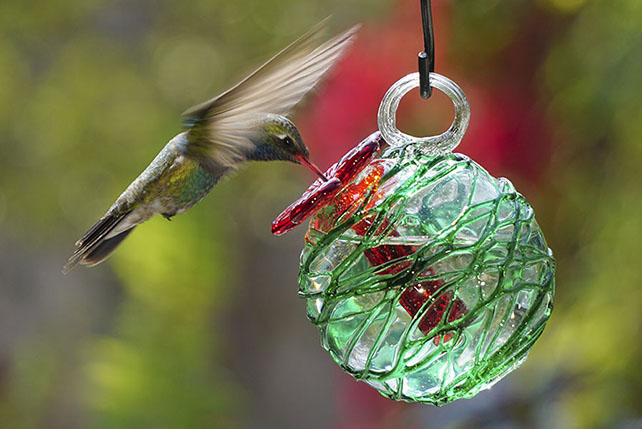Spring is here and the Hummingbirds are coming. The migration of hummingbirds heralds the coming of spring. Learn fun facts about hummingbirds as well as plants for your region that will attract them to your gardens!
Did you know that hummingbirds . . .
- eat, rest, then eat again approximately 60 times throughout the day
- do not feed at night but enter tupor, a short-term form of hibernation
- lap nectar with their tongues at the rate of about 13 licks per second
- are quite promiscuous and that male and female hummingbirds are rarely together peacefully for more than a few moments
- will lace together spider webbing to build their nests
- generally lay 2 eggs that are 10% to 20% of the mother's body mass
- eat spiders, aphids, gnats and other insects for proteins, vitamins and minerals
- will navigate back to their summer territory with such precision that they will return to the same patch of perennial wildflowers or hover at a nail where a favorite feeder was suspended
- enjoy dripping water and sprinklers
- are not attracted to plants by smell but by color and shape
Common Hummers Found in the United States include
Allen's Hummingbird - Selasphorus sasin
- southwestern Oregon to southwestern California; winters in Mexico
- migrates up the Pacific coast from Mexico
- partial to penstemon, monkey flower and paintbrush
Anna's Hummingbird - Calypte anna
- Pacific coast north to British Columbia and east to Arizona
- migrates east to west; Arizona birds fly west to California in mid-spring and return in late summer
- partial to eucalyptus and tree tobacco flowers
Berylline Hummingbird - Amazilia beryllina
- rare summer visitors to mountains of southeast Arizona
- in summer strays into southwestern United States
- partial thistles and nectar feeders
Black-chinned Hummingbird - Archilochus alexandri
- found in low elevations in the west; summers from British Columbia to central Texas and southern California
- migrates to western United States in spring and leaves for Mexico in fall
- often nests in backyards
Blue-throated Hummingbird - Lampornis clemenciae
- found in the southwestern part of the United States to southern Mexico
- migrates in spring; leaves in fall
- largest of U.S. breeding hummers. Partial to shady spots near water
Broad-billed Hummingbird - Cynanthus latirostris
- found in March to September in limited areas of AZ, NM, southwest TX; winters in Mexico
- migrates up from Mexico in spring; returns in fall
- limited range but abundant where found
Broad-tailed Hummingbird - Selasphorus platycerus
- Breeds in south and central Rockies and mountains of the Great Basin south into western Texas and Mexico; winters in Mexico
- migrates northward through lowlands in the spring and south through the mountains late summer
- classic hummingbird of the mountainous west
Buff-bellied Hummingbird - Amazilia yucatanensis
- resides in Mexico, Belize and Guatemala
- found in south Texas in summer
Calliope Hummingbird - Stellula calliope
- summers in mountains of western North America from the southwestern parts of Canada to Baja; winters in Mexico
- migrates northwest in early spring through Pacific lowlands; southeast in late summer through the Rocky Mountain region
- smallest of North American hummers but despite size is able to withstand cold summer nights at high elevations in the Rockies
Costa's Hummingbird - Calypte costae
- found in southwestern United States; mainly Arizona, California and New Mexico
- many hummers that nest in the desert will migrate west in the spring
Magnificent Hummingbird - Eugenes fulgens
- found in the southwestern United States to Panama; strays have been seen as far north as Minnesota
- migrates only a short distance south into Mexico for winter; few will overwinter in canyons of Arizona
Ruby-throated Hummingbird - Archilochus colubris
- only hummingbird found east of the Great Plains on a regular basis
- found in southeastern Canada to Gulf states; winters in south Texas, south Florida and western Panama
- partial to bee balm, trumpet creeper, columbine and red salvia
Rufous Hummingbird - Selasphorus rufus
- southwestern Oregon to southwestern California; winters in Mexico
- champion of long-distance migration. In spring moves northward through Pacific lowlands. Then beginning in late June moves through the Rocky Mountains and Sierra following the seasonal blooming of flowers; winters in Mexico but has been seen as far north as Alaska
- feisty and aggressive, will defend flowers or feeders from other birds
Violet-crowned Hummingbird - Amazilia violiceps
- found in a few places of southeastern Arizona and southwestern New Mexico
- seen mostly in summer
Plant listing to Attract Hummingbirds to your Garden
Hummingbird Feeder Maintenance and Nectar Recipe


